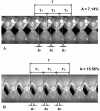Phase asymmetries in normophonic speakers: visual judgments and objective findings
- PMID: 18840697
- PMCID: PMC2632767
- DOI: 10.1044/1058-0360(2008/07-0059)
Phase asymmetries in normophonic speakers: visual judgments and objective findings
Abstract
Purpose: To ascertain the amount of phase asymmetry of the vocal fold vibration in normophonic speakers via visualization techniques and compare findings for habitual and pressed phonations.
Method: Fifty-two normophonic speakers underwent stroboscopy and high-speed videoendoscopy (HSV). The HSV images were further processed into 4 visual displays: HSV playbacks, digital kymography (DKG) playbacks, mucosal wave kymography playbacks, and static kymographic images of the medial line from the DKG playback. Two types of phase asymmetries, left-right and anterior-posterior, were rated on a scale from 1 to 5. Objective measures of left-right phase asymmetry were obtained.
Results: The majority of normophonic speakers (81%) were noted to display anterior-posterior asymmetry; however, 66% of those were characterized as mild. Seventy-nine percent of participants were noted to display left-right asymmetry; however, 72% of those were mild. A moderate relationship between the objective measures and subjective ratings was found.
Conclusions: Most normophonic speakers exhibit mild left-right and anterior-posterior asymmetries for both habitual and pressed phonations. Asymmetries were noted more often during habitual than pressed phonations, and when visualized by HSV and kymography than stroboscopy. Differences between objective measures and visual judgments support the need to quantify vocal fold vibratory features.
Figures





References
-
- Bless DM, Hirano M, Feder RJ. Videostroboscopic evaluation of the larynx. Ear Nose Throat Journal. 1987;66(7):289–96. - PubMed
-
- Bonilha H, Deliyski D. Period and Glottal Width Irregularities in Vocally Normal Speakers. Journal of Voice. 2008 in press. - PubMed
-
- Bonilha H, Aikman A, Hines K, Deliyski D. Vocal Fold Mucus Aggregation in Vocally Normal Speakers. Logopedics Phoniatrics Vocology. 2008 in press. - PubMed
-
- Deliyski DD. Endoscope motion compensation for laryngeal high-speed videoendoscopy. Journal of Voice. 2005;19(3):485–496. - PubMed
-
- Deliyski DD, Petrushev PP, Bonilha HS, Gerlach TT, Martin-Harris B, Hillman RE. Clinical implementation of laryngeal high-speed videoendoscopy: challenges and evolution. Folia Phoniatrica et Logopaedica. 2008;60(1):33–44. - PubMed
Publication types
MeSH terms
Grants and funding
LinkOut - more resources
Full Text Sources

